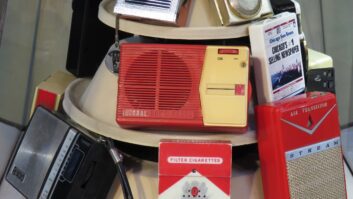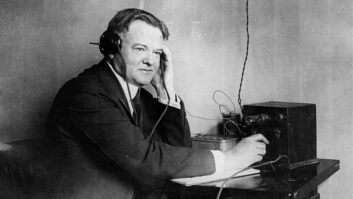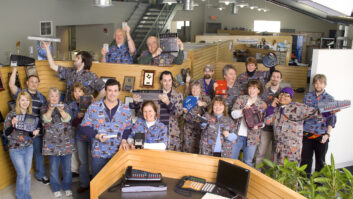Hams Give Second Life to Legendary Transmitters With Names Like RCA, Collins, Gates and Raytheon
(click thumbnail)A beautiful RCA BTA-1R is freed after years entombed behind some remodeling. The transmitter is now at the home of a Pennsylvania ham who plans to put it on 160 m shortwave.
Ever wonder what it would be like to fire up your radio station’s old transmitter after local signoff to talk casually with someone at the other end? And have them fire up their station’s old rig for some nostalgic chit-chat with you?
It’s done all the time on ham radio, the new home for fine, old vacuum-tube transmitters from Gates, RCA, Western Electric, Collins, General Electric, Raytheon and other “classic” names of broadcasting.
For More InfoThe AM Window. Technical discussion and documentation. www.thebizlink.com/am
AM International. Fraternity of vintage hams. http://ourworld.compuserve.com /homepages/sweetbay/amintern.htm
AM North America. E-mail reflector, links page. www.thebizlink.com/am
AM Classifieds. Surplus gear, including broadcast transmitters. www.bulletinboards.com /view.cfm?comcode=inr
Society of Broadcast Engineers.www.sbe.org
Electric Radio. Monthly magazine featuring stories about vintage operating.
Phone/FAX (970) 564-9185
Amateur Licensing.www.w5yi.com/
A retired broadcast transmitter often gets pushed to a dusty, dark back corner of the technical room at a radio station. Increasingly, ham radio operators are giving a second life to these graceful old beauties, donated or sold cheaply to hobbyists by stations with no further need.
Walsh, Dorrough and Balsamo
The attraction of a “heavy metal” radio is part of a vintage specialty in the hobby, and it resembles old car collecting. Some of the radios even take their styling cues from automobiles of the era.
Technically-minded experimenters drawn to “hollow-state” vacuum-tube technology nurture, build and restore all manner of “classic” radios, including those from maritime and military communications.
Ham Under Glass – and ChromeSome 80 amateur radio operators sport retired broadcast transmitters as part of their shortwave setups. To find the city of license for any of the operators, look up their call letters on the free online database at www.QRZ.com.
Martin, WB6OFM, Collins 300-G
Bill, N7OTQ, Collins 20V3 (75m), 20V2 (160m)
Barry, N6CSW, Collins 300-G
Rolynn, K7DFW, Collins 20V3, and Gates BC1-T on 75m
Mike, W2ZE, RCA BTA-250K on 160m
Gregg, WA2IAC, Gates BC1H
William, AB6MT, Collins 20V2 on 75m
Larry, WA9VRH, Collins 20V2
Tom, W2ILA, Collins 300-G
Chris, KC4CMR, Gates BC1-G
Clyde, K4UXK, Gates BC1T
Bruce, WX1O, Gates BC 250GY
Bill, N3JDR, Gates BC1 on 160m
David, W6PSS, RCA BTA-250M on 160m
Richard, W9LDB, Collins 300J on 160m
Marion, W7UO, Gates BC1-G on 160m
Gary, W6UH, Collins 20V-2 on 160m
Jim, K7EWE, Gates BC-250GY on 160m
Gary W7GMK Bauer 707, on 160m
Fred KF0OW, Gates BC-250GY, on 160m
Doug, W5JV, Collins 300-G on 160m
Bob, K2NK, Gates BC-250GY, on 160m
John, N9QWH, Gates BCA250
Jeff, W5OMR, RCA BTA-1R
Steve, WD8DAS, Gates BC1-H
Ron, WB0MBZ, GE BT-20A
Tim, W3TIM/4, Gates BC1H
Chaz, K8RNM, Gates 250GY
Barry, N6CSW/0, Gates 250GY
Glen, N4VL, 1950 Gates BCA 250 160-75-40, ‘67 Gates BC250GY on 75
Jim, K4EDK, Bauer 707
Eric, WB4VVI, RCA 250H, 160, CCA AM1000, 160
Tony, W5OD, Collins 20V3
Dudley, WA5SVL, Collins 20V2
Gregg, K9CBD, Collins 300-J
Dean, KK1K, RCA BTA 250M On 160m
Andy, WA4KCY, Gates BC-250GY 75m
Gary, W3AM/4 Florida, Collins 20V2
Paul, VE7KHZ, RCA BTA-250M, 160/75
John, WB5OAU/4, Collins 550A-1,
Larry, WB8SKV, Western Electric 451A-1 (6) 211A on 160, and RCA 250H
Mike, W1JZ, RCA BTA-1 160m TBD, Raytheon RA-250
Joe, N2YR, 1948 Gates BC-250GY On 75m
Joe, WA3GMS, 1946 Gates 250C-1
Joe, WA2PJP, 1953 Collins 20V2
Chuck, WA4HHG, Collins 20V2 On 160m
Tom W2KBW, Collins 20V on 160, 75 & 40m
Sam, KI4AE, RCA BTA-500MX
Jim, W3ATV, RCA BTA-1MX
Arnie, K0AS, Raytheon (pair of 304TLs into a pair)
Keith, K0KE, Gates BC-1
Bill, WA8LXJ, Collins 231-D, (pair of 450-T into pr. of 750-T) 160/75m
Mike, WN3B, Gates 250C-1 On 40m
Dave, WB3ETN, Gates 250C-1 on 160m
Frank, K0BRA/4, Gates BC-250GY, 160m
Dale, KW1I, Collins 300-G On 160m
Jim, WA2WHV, General Electric XT-1 On 160m
Gary, N2INR, 1949 Collins 21E On 75m
Jerry, KG2BK, Raytheon RA1000, and RA250 Not presently on-air
Scott, N0BST, Collins 300-G, Gates BC1-T
Steve, WB3HUZ, 1946 General Electric BT-20A On 160m
Steve, N8JRJ, Gates BC-1G (75m), and Gates BC500T (160m) and GE BT-20A
(160m)
Mike, KO6NM, Collins 820-D. On 75m
Jim, W8MAQ, 1948 Collins 300-G, 160 and 75m
Howard, W3HM/8, Collins 20V and a Gates BC-500. On 160m
Phil K2PG: Two Collins model 20V’s on 160
Paul WA3VJB: 1949 Collins 300-G on 40, 75 and 160m
Bill, N2BC, RCA BTA 1R1 160m
Ed N2CWJ: 1961 Collins 20V3
Bob W2ZM: RCA BTA250K, BTA-1MX, and Northern Electric 451A-1, all 160m
Sparks W4AES: Bauer 707
Ed, VA3ES, 1968 RCA BTA1-R3; and ‘70 RCA BTA1-S, not on air
Dale, VE3AAM, Gates BC5-P (pair of 3CX2500 into a pair) 75m
Bill, K2LNU, Gates BC1-H on 160 and 75m
Al, W1UX, RCA RCA BTA-500MX
John, W6BM, Collins 20K 160m, RCA BTA-1R, 75m
Sam, W6HDU: RCA BTA-250K 160m, Western Electric 443A 160m, W-E 451A-1 and
23A (both on 160m), Collins 20V2 on 75m
Mike, W6THW, Collins 300-G 160m, W-E 12B and 71B on 160, Collins 20T
Bill, AB6MT, RCA BTA-250M 160m, Bauer 707 75m, GE BT-20A 160m, and G-E
XT-1A on 75m
Doc, K6HLO, RCA BTA1-K
Mike, K6KKM, Collins 300J on 75m
Ike, W4KKO, Gates BC-1T
Tom, N5AMA, Gates BC-250-GY
Many broadcast engineers happen also to be ham radio operators. In some cases they have gotten into their careers thanks to years of “playing radio.” These hams may play by day with the latest technology, but remain delighted to stay in touch with discrete components, point-to-point wiring and the ornate hardware and craftsmanship not found in the typical contemporary transmitter.
Fans of these heavily chromed, glass-window transmitters include rock star Joe Walsh, whose ham call signs are WB6ACU; Mike Dorrough, of broadcast audio fame, call sign K06NM; and Nick Balsamo, KG2IR, a recording engineer known for his work with Sony Music, Studer and now NBC. All three gentlemen devote a lot of their ham-radio hobby to vintage, vacuum-tube equipment.
Leisure time spent bringing back a chrome-and-glass transmitter leads to large gatherings on the shortwave ham bands, where the rigs are demonstrated in their full glory. Nighttime propagation is especially reminiscent of the early days of radio, as people warm up their radios for hours of storytelling and technical discussion with other enthusiasts far and near.
Vintage stations often place an emphasis on high-fidelity reception as well as striving toward good transmitted audio. Some hams listen on the big speaker of an antique floor console with shortwave bands such as those from Philco, GE, Crosley and Zenith. Occasionally, a ham running AM gets reception reports from an “SWL,” a shortwave listener who has picked up the signals on an antique radio or perhaps with a modern “world-band” receiver.
Heavy metal
The pasttime has become so popular that there now is a Heavy Metal Rally on the 160-meter ham band, around 1885 kc (the old fashioned “kc” reference is deliberate). You’ll notice this frequency is not far from the Standard Broadcast Band, where the old rigs gave years of faithful service to their communities in the days before television.
The first Heavy Metal Rally last December drew about 25 broadcast transmitters nationwide, each with hams at the switch. There are now more than 70 amateur operators across the country who have placed retired broadcast transmitters on the shortwave ham bands (see sidebar).
The first Heavy Metal Rally honored grand old AM broadcast transmitters, and also marked the centennial of the world’s first “phone” transmission, Dec. 23, 1900. Experimenter Reginald Fesseden used an amplitude-modulated spark gap transmitter to communicate a short distance from a site at Cobb Island, Maryland along the Potomac River.
The Heavy Metal event, which featured an award for “best station” decided by popular vote, was sponsored by Electric Radio magazine, a publication dedicated to vintage ham radio activity. The event was the brainchild of Bill Kleronomos, KD0HG, the chief engineer of a broadcast station in Denver. The trophy features a brass portrayal of a classic ribbon mic, with some lightning bolts. The winner was Mike McElhinny, WN3B, running a Gates BC-250GY from his Pennsylvania home.
New wavelengths
Technically, it often takes little to recrystal and retune a transmitter from its radio station frequency to a new home on the shortwave ham bands.
Some new owners additionally have done considerable research and have reconfigured driver and RF tank circuits for greater power efficiency, better harmonic suppression and expanded frequency agility.
Modifications typically involve a certain loyalty to the original look and design of the transmitter. The hobbyist-engineer might use components of the original vintage like ceramic coil forms and mica capacitors, even drawing on NOS (new old stock) components carefully procured from years of searching hamfest “flea markets,” or more recently, from online bulletin boards or auction sites catering to vintage equipment.
Reworking the original single-frequency circuitry allows such transmitters to operate not only on 160 meters, as mentioned, but also on 75 meters (around 3880 kc) and all the way to the 40-meter ham band. Here, many AM rigs can be found between 7280 kc and just below 7300 kc, the limit of the allocation for the amateur service on this band.
Retro radio
When the revival of interest in vacuum-tube gear first gained momentum, many hams involved with mainstream activities were puzzled at the “retro” approach taken by others who were getting together in what was seen as an eccentric little sub-group.
Part of the allure involves the pleasure of a technical pursuit, which has become far more difficult for the average ham to accomplish with today’s technology. The most common activities in the hobby do not include much radio homebrew and experimentation, but instead focus on using pre-determined circuitry in radios with a heavy emphasis on computer technology to provide operating features.
Another explanation for the attraction to “classic” radios comes from the feeling of participating in making the radios “work” to communicate through the aether. Pushing buttons on a modern radio may feel constrained compared to being actively involved manipulating Plate and Load controls, and hearing the solid ker-thunk of relay contacts keying a 50-year-old transmitter that you’ve restored to operating perfection.
These hams might have a modern transceiver of some kind for emergency work, because the amateur community often is called upon to supply disaster communications. But the preference in the “AM Community” is to seek equipment from long-gone American manufacturers like Hammarlund, Hallicrafters and Drake.
Enthusiasts then arrange a delightful mix of vintage ham, military, maritime, industrial and broadcast communications gear in their stations.
Bigger is not better
For a ham-radio operator, practical and residential considerations limit the list of desirable broadcast transmitters to those using single-phase line voltage, designed for RF power output of 1 kilowatt or under, and which take up “only” a single cabinet’s worth of space.
That leaves a lot of transmitters to unearth and place in good homes. Among the most popular are the Gates BC-250GY and BC-1, the Collins 300-G and 20V, and the RCA BTA 500 and BTA-1.
Less commonly found are rigs like the GE BT-20A, among the smallest of the vintage broadcast transmitters at roughly the size of a standard 19-inch panel/seven-foot equipment rack. At the other end of the scale is the enormous, 2,300-pound Raytheon RA-1000. At least two examples of the Raytheon have made it to the ham bands.
A company that had a foot in both the broadcast and ham radio camps was the Collins Radio Co., founded by the late Art Collins, W0CXX. Well-regarded for quality amateur receivers and transmitters, the company’s broadcast transmitter offerings now enjoy special status in the vintage community.
The 1946-49 Collins 300-G has a viewing window surrounded by chrome to show off a row of 810 triodes from left to right. In a darkened room, it looks like a quad of barn lanterns at full wick, very impressive.
The same effect comes through the picture window of the Gates BC-1 and the GE XT-1, both with a quad of 833A triodes. The Bauer 707 has a similar layout using 4-400s, each glowing behind a glass chimney like the wick of a kerosene heater.
Familiar technical standards
Ham radio’s vintage specialty is one of the last venues where someone can get practical, hands-on expertise at troubleshooting radio circuitry outside of academic or workplace settings.
Experimentation takes place without the pressure of having to get “back on the air” immediately, as when a broadcast station is knocked off by a technical problem. The hobby also provides an opportunity to apply what’s been learned elsewhere to a pleasurable pasttime.
The Society of Broadcast Engineers has, for years, offered instant certification as a Broadcast Technologist to hams with the highest class of amateur licensing (“Extra” Class). This is in recognition of the technical achievement involved in passing ham radio’s most rigorous FCC exam on circuit fundamentals.
In the Amateur licensing structure, federal regulators have discontinued a challenging high-speed Morse code requirement. This challenge had, in recent years, been cited as an obsolete holdover that often blocked many broadcast engineers from joining Amateur radio. Now, any of the shortwave ham licenses require only an entry-level, slow-speed code test. License exams continue to be conducted by certified teams of volunteers.
His first broadcast rig was a 1946 GE BT-20A, a 250-watt unit using two 828 tubes modulating a pair of 810s. “It cost me $1 a watt,” he writes.Reach him through “The AM Window” bulletin board at www.thebizlink.com/am/wwwboard/wwwboard.html








